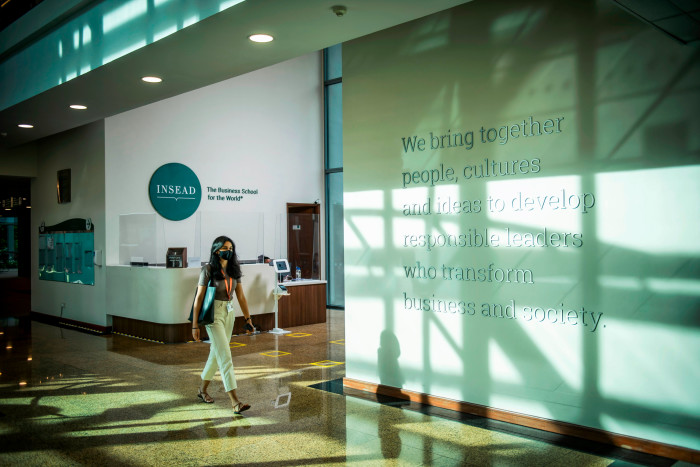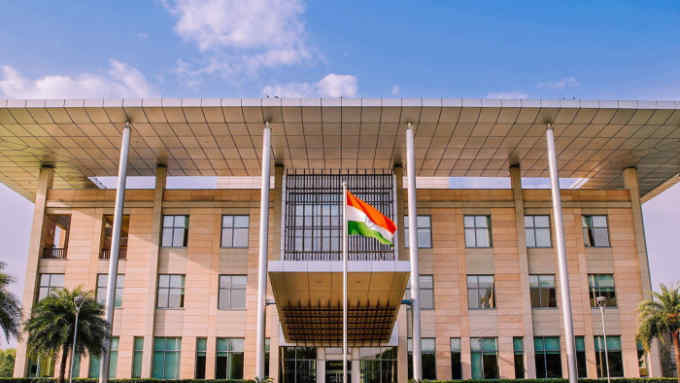Strong local demand buoys Asia’s business schools

Roula Khalaf, Editor of the FT, selects her favourite stories in this weekly newsletter.
As he gears up for his next intake of students, Yuan Ding has no doubts about the surging appetite for high-quality business education in Asia — but rather more about how far constraints beyond his control will limit his ability to provide it.
Against the backdrop of the Covid pandemic, the dean of the China Europe International Business School (Ceibs), says: “Domestic demand has been very strong. The only issue is the delivery. With current controls, it’s very uncertain.”
The government’s continued local lockdowns, designed to limit the spread of coronavirus, are constraining the ability of local students either to travel to his campus in Shanghai, or to participate in its placements abroad. And China’s reluctance to issue visas to foreigners is a still greater blow, undermining his ability to attract international students keen to come and learn about the country.
His experience at Ceibs, co-founded by the Chinese government and the European Union in 1994, reflects the way domestic policy is holding back an underlying structural trend towards a higher quantity and quality of business education right across the continent.
The pattern is captured in the latest FT directory of Asia-Pacific business schools. One in five in the FT annual ranking of Global MBAs is from the region, with eight institutions among the top 50. Several of the top-ranked schools for Executive MBAs are from China or Hong Kong alone. Many perform well by international standards, including for alumni earnings adjusted for purchasing power parity.
There is little doubt about appetite for the skills and networks that a growing number of business schools provide. China and India, in particular, have become ever larger exporters of students who seek to study and gain experience in Europe and North America, as well as Australia. They have also been increasingly able to offer good places to study nearer to home.
When Insead, the French-based institution, opened its campus in Singapore at the start of the millennium, any initial scepticism was rapidly overcome, according to Ilian Mihov, the dean. “There is a huge increase in demand for business education the region, consistent with the growth we see as the economies develop,” he observes.
He says applications, notably from China, have stretched the school’s principle of seeking to maintain diversity by limiting the proportion of students from any one country to less than 12 per cent of the total.

That same uptick applies to the appetite for non-degree courses. “It was a bit difficult to sell executive education courses at first, for which the cost is pretty high,” he says. “Companies were not that interested. But, with the trends in digitalisation, [and] the need to continuously upgrade and update your employees, more and more companies say there has to be more and continued training.”
Jean Charroin, dean of Essca, a French business school with a programme in Shanghai, has no doubts about rising demand. He cites efforts by China to attract foreign students to study in its own universities, bolstered by the Shanghai university rankings which have showcased and promoted its own institutions. “China considers itself an importer of students,” he says. “It is drawing in more and more from Africa, East Asia and Latin America.”
Yet the temporary restrictions linked to the pandemic have forced him to suspend courses in the country and pushed Essca to refocus on expanding operations in campuses across Europe. “We can’t say if we’ll be back in Shanghai in 2023-24,” he says.
A combination of the pandemic, lower costs, and an appetite for education geared to local needs has helped fuel expansion at schools in other Asian countries, however.
One example is the Sasin School of Management in Thailand, originally created in partnership with the Wharton School and Kellogg in the US. It largely teaches Thai students with a faculty that includes many visiting professors.
Ian Fenwick, its dean, says that, alongside classic business school skills, training has focused on entrepreneurship and family business, as well as mindfulness and even equine therapy. “Half of our students went abroad for [secondary] school and then their parents call[ed] them back to prepare them to take over the company. They need to build their network.”
Many other business schools in Asia are also placing emphasis on distinctive aspects of their national or regional managerial cultures and their corporate structures. This is being achieved through teaching cases that feature local protagonists and issues to supplement the large historical corpus describing US companies and executives.
“Gone are the days we would bend down to anyone from the English-speaking world,” said Krishnamurthy Subramanian, a former adviser to the Indian government, at an event in London last month celebrating the 20 years of the Indian School of Business in Hyderabad. He instead highlighted his country’s distinctive contribution to business and economics.
In a talk on “Indian thought”, he stressed the many centuries of the nation’s global economic prowess, a longstanding respect of property rights, and traditions of tolerance and values-based management.
But, while such insights are valuable, some worry that they risk fuelling nationalism at a time of growing authoritarianism and a stand-off in the exchange of ideas, people, trade and investment. Nowhere is this currently greater than in relations between China and the West.
“The tensions have certainly put a lot of restrictions on business, but at the student level I don’t feel a difference,” says Prof Kai Lung Hui at Hong Kong University of Science and Technology. “They remain eager, [and] still have a strong urge to follow globalisation and to make themselves international citizens.”

Comments